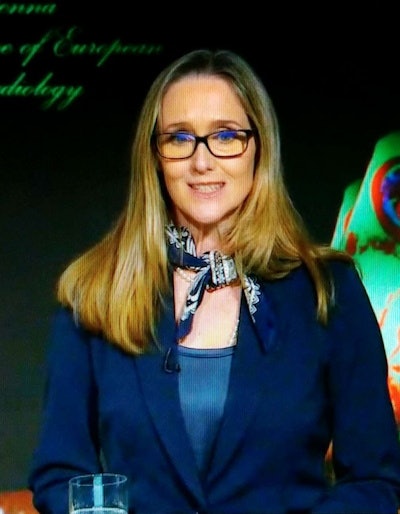
The radiologists of 2030 are likely to be subspecialized, trained in how to communicate with patients, and augmented -- but not replaced -- by artificial intelligence (AI), according to a presentation on 2 March at ECR Overture.
In a trailer session moderated by European Society of Radiology (ESR) President Prof. Dr. Regina Beets-Tan, PhD, and Chairman of the ESR Board of Directors Prof. Dr. Michael Fuchsjäger, panelists discussed their vision for the future of radiology.
To set the scene for the panel discussion, Prof. Andrea Rockall of Imperial College London presented results from a survey of ESR's membership conducted in 2019-2020.
Members were asked about their clinical role and training; their role in patient and professional relationships; and their role in education, research, management, and service development.
Training, subspecialization
Of the respondents, 70% indicated that they had received a period of medical training in a nonradiological clinical setting. Also, 80% felt that radiologists should have a mandatory period of nonradiology clinical experience, either before or during radiologist training.
 Prof. Andrea Rockall.
Prof. Andrea Rockall.In terms of subspecialization, approximately 52.5% did not undertake a period of subspecialist training or clinical fellowship. However, over 90% of respondents thought it was important for radiologists to have an area of subspecialization, noted Rockall, who was recently elected second vice-president of the ESR.
"So we can see this shift as to how people were trained, and how they perhaps would have liked to have been trained," she said. "And we can see this perhaps as a trend for the future."
The respondents believed that having a subspecialty accreditation improves their identity as a radiologist, both for their own perception (over 84% either strongly agreed or agreed) and for the perception of their clinical colleagues (nearly 87% either strongly agreed or agreed). It was deemed to be less important for patients (just over 70% strongly agreed or agreed that subspeciality accreditation improved their identity to patients).
| Improved identity as a radiologist from having subspecialty accreditation | |||||
| Strongly disagree | Disagree | Neutral | Agree | Strongly agree | |
| To the radiologist's own perception | 2% | 3.2% | 11.5% | 41.4% | 42.7% |
| To the radiologist's clinical colleagues | 1% | 1% | 10.6% | 40.8% | 45.9% |
| To patients | 1.8% | 3.2% | 24.5% | 35.3% | 35.2% |
When asked if it was important for a radiologist's identity to be a visible member of an organ-based clinical service, 61% strongly agreed, 25.9% agreed, 3.9% were neutral, 1.1% disagreed, and 4% strongly disagreed.
Job enjoyment
When asked to rate their enjoyment of different aspects of their jobs, the top responses (with either agree or strongly agree ratings) were the following:
- Interaction with radiology colleagues: 87.9%
- Being a specialized radiologist: 87.4%
- Interaction with clinical colleagues: 86.8%
- Involvement in multidisciplinary tumor board: 79%
- Teaching: 74.9%
- Interaction with patients: 74.2%
"All of these things that we enjoy are helpful in terms of preventing burnout and sustaining ourselves in a long career," Rockall said.
When asked what they would wish to change about their job, nearly half reported that they would like to have a lower workload.
"And, unfortunately, with too few radiologists in many countries, the level of workload is relentless," Rockall added.
Some other areas that radiologists would like to do more of include serving as a researcher or investigator, she said.
Patient interaction
Over 70% of respondents would like the same level of interaction with patients.
In other results, 88.6% indicated that a trained radiological assistant such as a radiographer or radiology nurse could help to describe the imaging procedure to the patient in order to improve patient experience as well as efficiency, according to Rockall.
"And we actually had hundreds of responses about how this could be helpful in improving the patient experience within our departments," she said.
But radiologists also have to communicate with patients in order to give them a good patient experience, Rockall said. Over 80% also believed that radiologists should be given formal communication training that's customized to the radiology setting. Of those respondents, over 90% indicated that formal communication training should be provided for communicating bad news and communicating significant imaging findings.
As for communicating errors, 33.1% felt it was very important in the role of the radiologist, while 46% believed it was important and 17.3% deemed that task to be moderately important.
Radiologists are often also playing a role in education, providing training for audiences such as medical students, doctors in training who are non-radiologists, radiographers, radiologists in subspecialist training, nurses, and even other paramedical staff, she said.
"This really demonstrates the breadth of imaging in our clinical care today," she said. "And our role in training the wider group of healthcare professionals is very important."
Although many radiologists reported they provided training, only 31% had received any formal training to teach, Rockall said.
Future trends
Based on these survey results, what are the likely trends that will be evident in 2030?
First off, the survey demonstrates that radiologists highly value a period of clinical training, Rockall noted.
Also, it's likely that radiologists will become more subspecialized, according to Rockall.
"And this seems to be important for job satisfaction, as well as for the visibility of the radiologists," she said.
As for modalities, CT and MRI are the real workhorses at the moment, Rockall said. In addition, oncology imaging was the main focus of a very high proportion of radiologists.
Workload is also a heavy burden for radiologists, but this could be an area in the future where AI could be of assistance, she said.
"We do need to look at building our workforce, however," Rockall added.
Radiologists also highly value interaction with radiology and clinical colleagues, she said. Furthermore, they find involvement in multidisciplinary tumor boards to be important.
Education is also likely to be an important issue, including for communicating with patients; 80% of the survey respondents recommended communications training for radiologists, Rockall said.
"[And] teaching across many professional areas is likely to continue due to the widespread, increasing role of imaging in healthcare," she said.



















